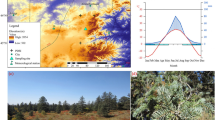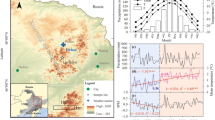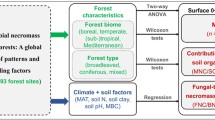Abstract
Unravelling the role of structural and environmental drivers of gross primary productivity (GPP) and ecosystem respiration (R eco) in highly heterogeneous tundra is a major challenge for the upscaling of chamber-based CO2 fluxes in Arctic landscapes. In a mountain birch woodland-mire ecotone, we investigated the role of LAI (and NDVI), environmental factors (microclimate, soil moisture), and microsite type across tundra shrub plots (wet hummocks, dry hummocks, dry hollows) and lichen hummocks, in controlling net ecosystem CO2 exchange (NEE). During a growing season, we measured NEE fluxes continuously, with closed dynamic chambers, and performed multiple fits (one for each 3-day period) of a simple light and temperature response model to hourly NEE data. Tundra shrub plots were largely CO2 sinks, as opposed to lichen plots, although fluxes were highly variable within microsite type. For tundra shrub plots, microsite type did not influence photosynthetic parameters but it affected basal (that is, temperature-normalized) ecosystem respiration (R 0). PAR-normalized photosynthesis (P 600) increased with air temperature and declined with increasing vapor pressure deficit. R 0 declined with soil moisture and showed an apparent increase with temperature, which may underlie a tight link between GPP and R eco. NDVI was a good proxy for LAI, maximum P 600 and maximum R 0 of shrub plots. Cumulative CO2 fluxes were strongly correlated with LAI (NDVI) but we observed a comparatively low GPP/LAI in dry hummocks. Our results broadly agree with the reported functional convergence across tundra vegetation, but here we show that the role of decreased productivity in transition zones and the influence of temperature and water balance on seasonal CO2 fluxes in sub-Arctic forest–mire ecotones cannot be overlooked.








Similar content being viewed by others
References
Alm J, Schulman L, Walden J, Nykänen H, Martikainen PJ, Silvola J. 1999. Carbon balance of a boreal bog during a year with an exceptionally dry summer. Ecology 80:161–74.
Alm J, Talanov A, Saarnio S, Silvola J, Ikkonen E, Aaltonen H, Nykänen H, Martikainen PJ. 1997. Reconstruction of the carbon balance for microsites in a boreal oligotrophic pine fen, Finland. Oecologia 110:423–31.
Asner GP, Scurlock JMO, Hicke AJ. 2003. Global synthesis of leaf area index observations: implications for ecological and remote sensing studies. Glob Ecol Biogeogr 12:191–205.
Atkin OK, Bruhn D, Tjoelker MG. 2005. Response of plant respiration to changes in temperature: mechanisms and consequences of variations in Q10 values and acclimation. In: Lambers H, Ribas-Carbó M, Eds. Advances in photosynthesis and respiration. Plant respiration: from cell to ecosystem. Dordrecht: Springer. p 95–135.
Beck PSA, Juday GP, Alix C, Barber VA, Winslow SE, Sousa EE, Heiser P, Herriges JD, Goetz SJ. 2011. Changes in forest productivity across Alaska consistent with biome shift. Ecol Lett 14:373–9.
Boelman NT, Stieglitz M, Griffin KL, Shaver GR. 2005. Inter-annual variability of NDVI in response to long-term warming and fertilization in wet sedge and tussock tundra. Oecologia 143:588–97.
Boelman NT, Stieglitz M, Rueth HM, Sommerkorn M, Griffin KL, Shaver GR, Gamon JA. 2003. Response of NDVI, biomass, and ecosystem gas exchange to long-term warming and fertilization in wet sedge tundra. Oecologia 135:414–21.
Bosiö J, Johansson M, Callaghan T, Johansen B, Christensen T. 2012. Future vegetation changes in thawing subarctic mires and implications for greenhouse gas exchange—a regional assessment. Clim Chang 115(2):379–98. doi:10.1007/s10584-012-0445-1.
Bubier J, Crill P, Mosedale A, Frolking S, Linder E. 2003. Peatland responses to varying interannual moisture conditions as measured by automatic CO2 chambers. Glob Biogeochem Cycles 17:1066.
Burrows EH, Bubier JL, Mosedale A, Cobb GW, Crill PM. 2005. Net ecosystem exchange of carbon dioxide in a temperate poor fen: a comparison of automated and manual chamber techniques. Biogeochemistry 76:21–45.
Cai T, Flanagan LB, Syed KH. 2010. Warmer and drier conditions stimulate respiration more than photosynthesis in a boreal peatland ecosystem: analysis of automatic chambers and eddy covariance measurements. Plant Cell Environment 33:394–407.
Christensen JH, Hewitson B, Busuioc A, Chen A, Gao X, Held I, Jones R, Kolli RK, Kwon WT, Laprise R. 2007. Regional climate projections. In: Solomon S, Qin D, Manning M, Chen Z, Marquis M, Averyt KB, Tignor M, Miller HL, Eds. Climate change 2007: the physical science basis. contribution of working group I to the fourth assessment report of the intergovernmental panel on climate change. Cambridge, UK/New York, USA: Cambridge University Press. p 847–940.
Dagg J, Lafleur P. 2010. An application of plot-scale NDVI in predicting carbon dioxide exchange and leaf area index in heterogeneous subarctic tundra. Can J Remote Sens 36:S111–23.
Dagg J, Lafleur P. 2011. Vegetation community, foliar nitrogen, and temperature effects on tundra CO2 exchange across a soil moisture gradient. Arct Antarct Alp Res 43:189–97.
Dorrepaal E, Toet S, Van Logtestijn RSP, Swart E, Van de Weg MJ, Callaghan TV, Aerts R. 2009. Carbon respiration from subsurface peat accelerated by climate warming in the subarctic. Nature 460:616–19.
Elmendorf SC, Henry GHR, Hollister RD, Björk RG, Boulanger-Lapointe N, Cooper EJ, Cornelissen JHC, Day TA, Dorrepaal E, Elumeeva TG, Gill M, Gould WA, Harte J, Hik DS, Hofgaard A, Johnson DR, Johnstone JF, Jónsdóttir IS, Jorgenson JC, Klanderud K, Klein JA, Koh S, Kudo G, Lara M, Lévesque E, Magnússon B, May JL, Mercado-Díaz JA, Michelsen A, Molau U, Myers-Smith IH, Oberbauer SF, Onipchenko VG, Rixen C, Schmidt NM, Shaver GR, Spasojevic MJ, Pórhallsdóttir PE, Tolvanen A, Troxler T, Tweedie CE, Villareal S, Wahren C-H, Walker X, Webber PJ, Welker JM, Wipf S. 2012. Plot-scale evidence of tundra vegetation change and links to recent summer warming. Nat Clim Chang 2:453–7.
Fletcher BJ, Gornall JL, Poyatos R, Press MC, Stoy PC, Huntley B, Baxter R, Phoenix GK. 2012. Photosynthesis and productivity in heterogeneous arctic tundra: consequences for ecosystem function of mixing vegetation types at stand edges. J Ecol 100:441–51.
Heikkinen JEP, Virtanen T, Huttunen JT, Elsakov V, Martikainen PJ. 2004. Carbon balance in east European tundra. Glob Biogeochem Cycles 18:1–14.
Heinemeyer A, Di Bene C, Lloyd AR, Tortorella D, Baxter R, Huntley B, Gelsomino A, Ineson P. 2011. Soil respiration: implications of the plant–soil continuum and respiration chamber collar-insertion depth on measurement and modelling of soil CO2 efflux rates in three ecosystems. Eur J Soil Sci 62:82–94.
Huemmrich K, Gamon JA, Tweedie CE, Oberbauer SF, Kinoshita G, Houston S, Kuchy A, Hollister RD, Kwon H, Mano M. 2010. Remote sensing of tundra gross ecosystem productivity and light use efficiency under varying temperature and moisture conditions. Remote Sens Environ 114:481–9.
Humphreys ER, Lafleur PM, Flanagan LB, Hedstrom N, Syed KH, Glenn AJ, Granger R. 2006. Summer carbon dioxide and water vapor fluxes across a range of northern peatlands. J Geophys Res 111:G04011.
Johnson LC, Shaver GR, Giblin AE, Nadelhoffer KJ, Rastetter ER, Laundre JA, Murray GL. 1996. Effects of drainage and temperature on carbon balance of tussock tundra microcosms. Oecologia 108:737–48.
Jones HG. 1992. Plants and microclimate: a quantitative approach to environmental plant physiology. Cambridge: Cambridge University Press. p 428 pp.
Kulmala L, Pumpanen J, Hari P, Vesala T. 2011. Photosynthesis of ground vegetation in different aged pine forests: Effect of environmental factors predicted with a process-based model. J Veg Sci 22:96–110.
Kulmala L, Pumpanen J, Vesala T, Hari P. 2009. Photosynthesis of boreal ground vegetation after a forest clear-cut. Biogeosciences 6:2495–507.
Kutzbach L, Schneider J, Sachs T, Giebels M, Nykanen H, Shurpali NJ, Martikainen PJ, Alm J, Wilmking M. 2007. CO2 flux determination by closed-chamber methods can be seriously biased by inappropriate application of linear regression. Biogeosciences 4:1005–25.
La Puma IP, Philippi TE, Oberbauer SF. 2007. Relating NDVI to ecosystem CO2 exchange patterns in response to season length and soil warming manipulations in arctic Alaska. Remote Sens Environ 109:225–36.
Larsen KS, Ibrom A, Beier C, Jonasson S, Michelsen A. 2007. Ecosystem respiration depends strongly on photosynthesis in a temperate heath. Biogeochemistry 85:201–13.
Limpens J, Berendse F, Blodau C, Canadell JG, Freeman C, Holden J, Roulet N, Rydin H, Schaepman-Strub G. 2008. Peatlands and the carbon cycle: from local processes to global implications: a synthesis. Biogeosciences 5:1475.
Lindroth A, Lund M, Nilsson M, Aurela M, Christensen TR, Laurila T, Rinne J, Riutta T, Sagerfors J, Ström L. 2007. Environmental controls on the CO2 exchange in north European mires. Tellus B 59:812–25.
Loranty MM, Goetz SJ, Rastetter EB, Rocha AV, Shaver GR, Humphreys ER, Lafleur PM. 2011. Scaling an instantaneous model of tundra NEE to the arctic landscape. Ecosystems 14:76–93.
Lund M, Lafleur PM, Roulet NT, Lindroth A, Christensen TR, Aurela M, Chojnicki BH, Flanagan LB, Humphreys ER, Laurila T. 2010. Variability in exchange of CO2 across 12 northern peatland and tundra sites. Glob Chang Biol 16:2436–48.
Maanavilja L, Riutta T, Aurela M, Pulkkinen M, Laurila T, Tuittila E-S. 2011. Spatial variation in CO2 exchange at a northern aapa mire. Biogeochemistry 104:325–45.
Mahecha MD, Reichstein M, Carvalhais N, Lasslop G, Lange H, Seneviratne SI, Vargas R, Ammann C, Arain MA, Cescatti A, Janssens IA, Migliavacca M, Montagnani L, Richardson AD. 2010. Global convergence in the temperature sensitivity of respiration at ecosystem level. Science 329:838–40.
Marushchak ME, Kiepe I, Biasi C, Elsakov V, Friborg T, Johansson T, Soegaard H, Virtanen T, Martikainen PJ. 2013. Carbon dioxide balance of subarctic tundra from plot to regional scales. Biogeosciences 10:437–52.
McMichael CE. 1999. Estimating CO2 exchange at two sites in Arctic tundra ecosystems during the growing season using a spectral vegetation index. Int J Remote Sens 20:683–98.
Moore TR, Bubier JL, Frolking SE, Lafleur PM, Roulet NT. 2002. Plant biomass and production and CO2 exchange in an ombrotrophic bog. J Ecol 90:25–36.
Natali SM, Schuur EAG, Rubin RL. 2012. Increased plant productivity in Alaskan tundra as a result of experimental warming of soil and permafrost. J Ecol 100:488–98.
Nobrega S, Grogan P. 2008. Landscape and ecosystem-level controls on net carbon dioxide exchange along a natural moisture gradient in Canadian low arctic tundra. Ecosystems 11:377–96.
Oberbauer SF, Tweedie CE, Welker JM, Fahnestock JT, Henry GHR, Webber PJ, Hollister RD, Walker MD, Kuchy A, Elmore E. 2007. Tundra CO2 fluxes in response to experimental warming across latitudinal and moisture gradients. Ecol Monogr 77:221–38.
Oechel WC, Vourlitis GL, Brooks S, Crawford TL, Dumas E. 1998. Intercomparison among chamber, tower, and aircraft net CO2 and energy fluxes measured during the Arctic system science land-atmosphere-ice interactions (ARCSS-LAII) flux study. J Geophys Res: Atmospheres 103:28993–9003.
Pelletier L, Garneau M, Moore T. 2011. Variation in CO2 exchange over three summers at microform scale in a boreal bog, Eastmain region, Québec. Can J Geophys Res: Biogeosci 116:G03019.
Pinheiro JC, Bates DM. 2000. Mixed-effects models in S and S-PLUS. New York: Springer. p 528 pp.
R Development Core Team. 2009. R: a language and environment for statistical computing. Vienna: R Foundation for Statistical Computing.
Riutta T, Laine J, Aurela M, Rinne J, Vesala T, Laurila T, Haapanala S, Pihlatie M, Tuittila E-S. 2007. Spatial variation in plant community functions regulates carbon gas dynamics in a boreal fen ecosystem. Tellus B 59:838–52.
Schuur EAG, Vogel JG, Crummer KG, Lee H, Sickman JO, Osterkamp TE. 2009. The effect of permafrost thaw on old carbon release and net carbon exchange from tundra. Nature 459:556–9.
Shaver GR, Street LE, Rastetter EB, Van Wijk MT, Williams M. 2007. Functional convergence in regulation of net CO2 flux in heterogeneous tundra landscapes in Alaska and Sweden. J Ecol 95:802–17.
Soegaard H, Nordstroem C, Friborg T, Hansen BU, Christensen TR, Bay C. 2000. Trace gas exchange in a high-Arctic valley: 3. Integrating and scaling CO2 fluxes from canopy to landscape using flux data, footprint modeling, and remote sensing. Glob Biogeochem Cycles 14:725–44.
Spadavecchia L, Williams M, Bell R, Stoy PC, Huntley B, Van Wijk MT. 2008. Topographic controls on the leaf area index and plant functional type of a tundra ecosystem. J Ecol 96:1238–51.
Stoy PC, Williams M, Evans JG, Prieto-Blanco A, Disney M, Hill TC, Wade TJ, Street LE. 2013. Upscaling tundra CO2 exchange from chamber to eddy covariance tower. Arct Antarct Alpine Res 45:275–84.
Street LE, Shaver GR, Williams M, Van Wijk MT. 2007. What is the relationship between changes in canopy leaf area and changes in photosynthetic CO2 flux in arctic ecosystems? J Ecol 95:139–50.
Street LE, Stoy PC, Sommerkorn M, Fletcher BJ, Sloan VL, Hill TC, Williams M. 2012. Seasonal bryophyte productivity in the sub-Arctic: a comparison with vascular plants. Funct Ecol 26:365–78.
Subke J-A, Heinemeyer A, Vallack H, Leronni V, Baxter R, Ineson P. 2012. Fast assimilate turnover revealed by in situ 13CO2 pulse-labelling in subarctic tundra. Polar Biol 35:1209–19.
Turunen J, Tomppo E, Tolonen K, Reinikainen A. 2002. Estimating carbon accumulation rates of undrained mires in Finland: application to boreal and subarctic regions. The Holocene 12:69–80.
Van Vliet-Lanoe B, Seppala M. 2002. Stratigraphy, age and formation of peaty earth hummocks (pounus), Finnish Lapland. The Holocene 12:187–99.
Van Wijk MT, Williams M, Shaver GR. 2005. Tight coupling between leaf area index and foliage N content in arctic plant communities. Oecologia 142:421–7.
Wayolle AAJ. 2011. Multiscale soil carbon distribution in two sub-arctic landscapes. PhD dissertation, University of Stirling, Stirling, UK.
Williams M, Street LE, Wijk MT, Shaver GR. 2006. Identifying differences in carbon exchange among arctic ecosystem types. Ecosystems 9:288–304.
Wohlfahrt G, Pilloni S, Hörtnagl L, Hammerle A. 2010. Estimating carbon dioxide fluxes from temperate mountain grasslands using broad-band vegetation indices. Biogeosciences 7:683–94.
Acknowledgments
Thanks to all the staff at the Kevo Subarctic Research Institute and to all the colleagues who collaborated in lab and fieldwork tasks, especially D. Sayer, T. August, K. Leslie and A. Robertson. Thanks to B. Fletcher, V. Sloan and G. Phoenix for their plant survey data and to T. Hill for the land classification map. We are grateful to P. Stoy and M. Williams for helpful comments on earlier versions of the manuscript and also to E. Rastetter for his feedback. This study was funded by NERC (UK) through the ABACUS consortium (Arctic Biosphere–Atmosphere Coupling at Multiple Scales, www.geos.ed.ac.uk/abacus; Grant No. NE/D005760/1), within the framework of the International Polar Year (2007–2008). RP also benefited from a contract within the MONTES project (CSD 2008-00040) and a ‘Juan de la Cierva’ fellowship, both funded by the Spanish Ministry of Science and Innovation.
Author information
Authors and Affiliations
Corresponding author
Additional information
Author Contributions
R.P. conceived and designed the study, performed research, analyzed data and wrote the paper; A.H. conceived and designed the study and revised the paper; P. I. conceived and designed the study and revised the paper; J.G.E. performed research, analyzed data and revised the paper; H.C.W. performed research, analyzed data and revised the paper; B.H. conceived and designed the study and revised the paper; R.B. conceived and designed the study and revised the paper.
Electronic supplementary material
Below is the link to the electronic supplementary material.
Appendix 1
Land classification map of the Petsikko field site, showing plot locations within the forest-mire ecotone (cf. Table 1 for the meaning of plot codes). The map is based on aerial photography taken in summer 2008 (T. Hill, unpublished). Coordinates are in UTM projection, zone 35N, datum WGS84. Supplementary material 1 (TIFF 863 kb)
Appendix 2
Statistics of the NEE model (DOY is day of year 2008). R 0 is basal respiration, β is respiration sensitivity to temperature, P max is asymptotic maximum photosynthesis, α is quantum efficiency and P 600 is gross photosynthesis at PAR = 600 µmol m-2 s-1. Adjusted R 2 and root mean square error (RMSE) are also shown. Supplementary material 3 (XLSX 32 kb)
Rights and permissions
About this article
Cite this article
Poyatos, R., Heinemeyer, A., Ineson, P. et al. Environmental and Vegetation Drivers of Seasonal CO2 Fluxes in a Sub-arctic Forest–Mire Ecotone. Ecosystems 17, 377–393 (2014). https://doi.org/10.1007/s10021-013-9728-2
Received:
Accepted:
Published:
Issue Date:
DOI: https://doi.org/10.1007/s10021-013-9728-2




